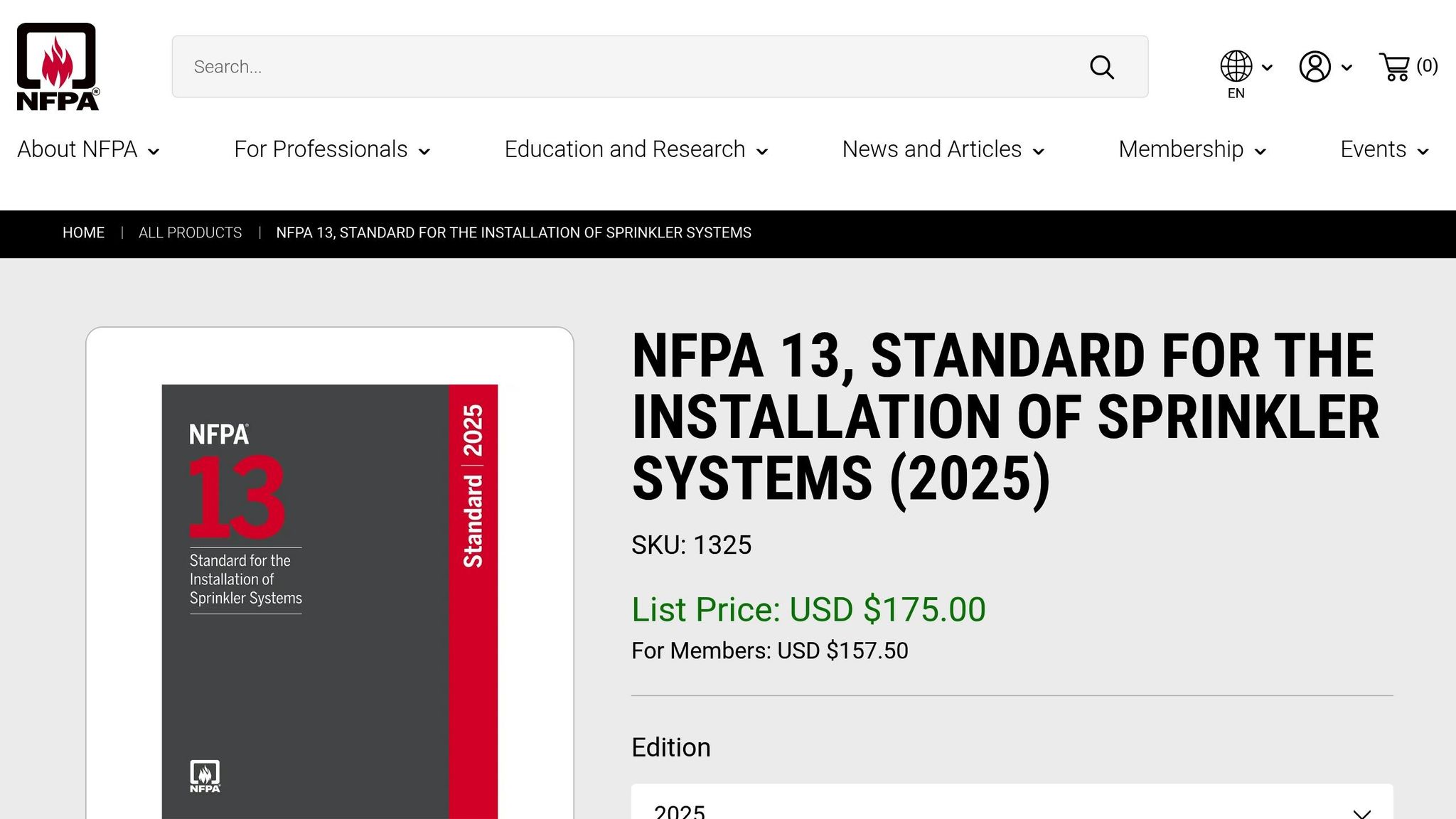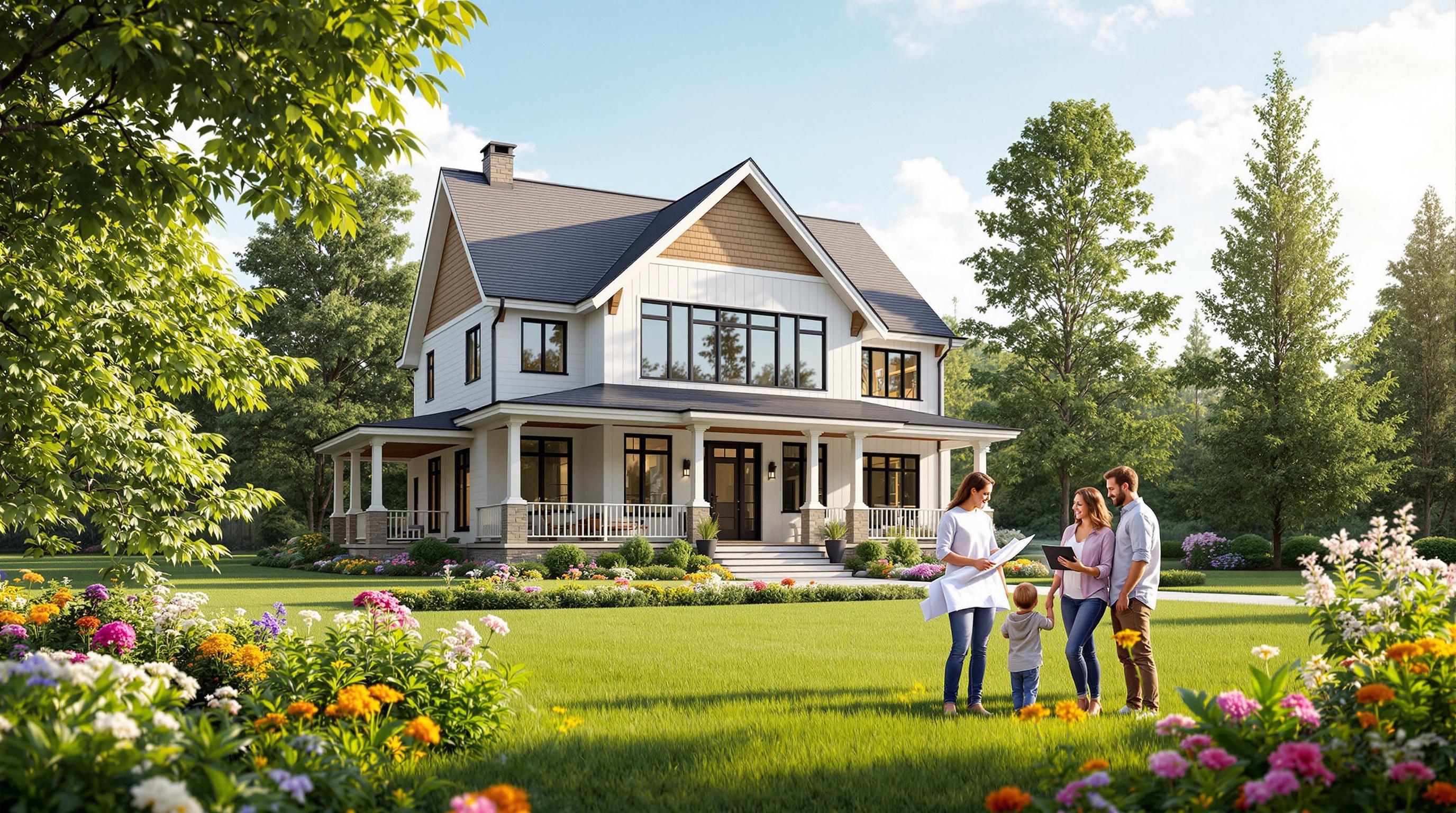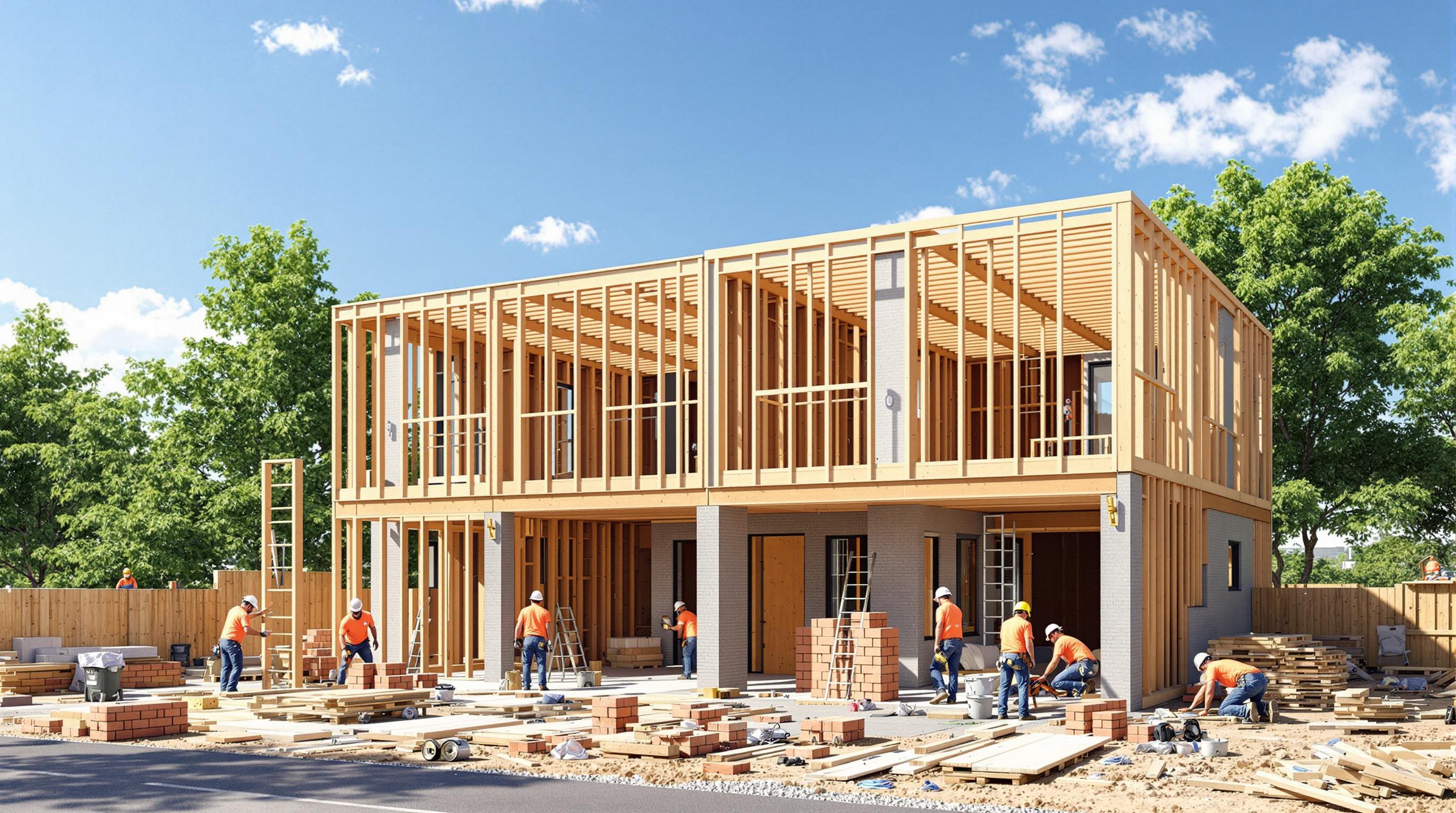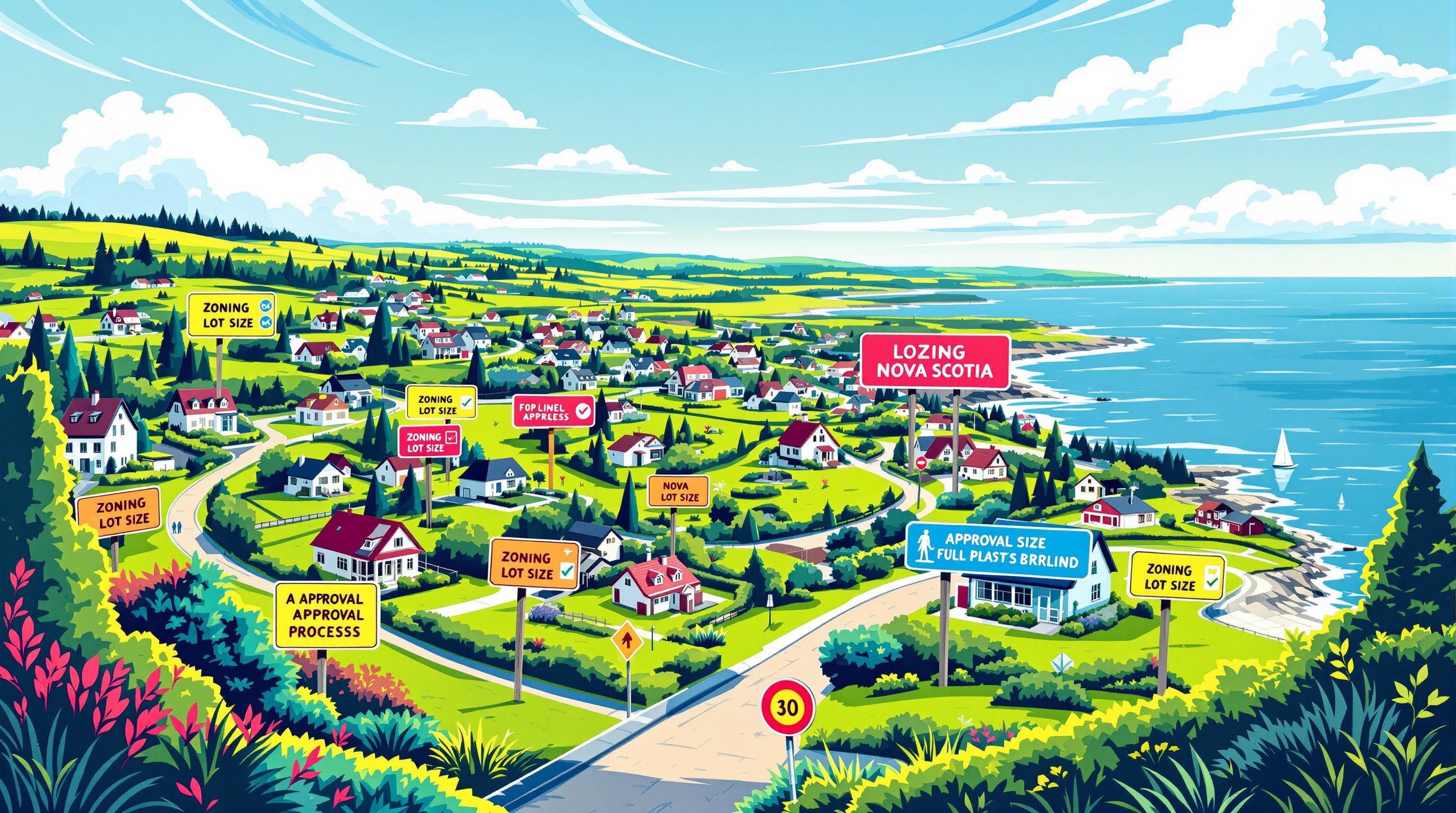NFPA 13 is the standard for designing and installing sprinkler systems in multi-unit residential buildings. In Nova Scotia, these standards are part of the provincial building code, ensuring safer living spaces, lower fire risks, and better property protection. Here’s what you need to know:
- Key Requirements: Proper water flow, sprinkler spacing, and freeze protection (e.g., dry-pipe systems for cold areas).
- Compliance Steps: Developers must secure permits, submit certified designs, and pass inspections (e.g., hydrostatic testing at 13.8 bar for 2 hours).
- Stakeholders: Developers, engineers, contractors, officials, and property managers all play roles in meeting NFPA 13 standards.
- Benefits: Safer buildings, reduced insurance costs, faster construction, and higher property value. For example, a $599,000 duplex built to NFPA 13 standards in Colchester appraised at $830,000.
NFPA 13 Main Requirements

System Design Standards
NFPA 13 outlines the criteria for designing sprinkler systems in multi-unit properties, taking into account occupancy types and hazard levels. Key design elements include:
- Properly calculated water flow rates
- Correct sprinkler head spacing
- Sufficient operating pressure
- Temperature ratings tailored to specific uses
In Nova Scotia's cold climate, additional precautions are necessary to prevent freezing. These include:
- Installing dry-pipe systems in unheated spaces like parking garages
- Using approved antifreeze solutions in specific zones
- Keeping valve rooms above freezing temperatures
These design considerations ensure the systems function effectively while meeting local building requirements.
Building Code Alignment
Local building codes add further requirements, such as standards for fire department connections, standpipe classifications based on building height, and specified water supply durations. Monitoring systems are also essential for quick detection and response during a fire.
To improve system performance, you might also consider:
- Integrating sprinkler systems with fire-rated unit separations
- Adding independent control zones for each floor with dedicated valves and flow switches
- Incorporating emergency power backup systems
- Using approved backflow preventers to protect municipal water supplies
These measures not only help meet code requirements but also enhance fire safety and streamline the permitting and inspection process.
Meeting Code Requirements
Permit Requirements
Before starting installation, you'll need to secure building and fire protection permits. This requires submitting detailed system designs, hydraulic calculations, and equipment specifications.
Key documents include:
- Drawings stamped by a licensed professional
- Hydraulic calculations to confirm water supply
- Equipment specifications and certifications
- Fire pump details (if applicable)
- Emergency power system documentation
- Backflow prevention certification
Working with an integrated design-build team can speed up the permit approval process. Rental property owner Sonia M. highlights the benefits:
"I've built before and was burned by endless 'surprise' bills. With Helio, the final price never changed - even when materials got scarce. I'd trust them again in a heartbeat." [1]
Once permits are approved, inspections ensure the system complies with NFPA 13 standards.
Required Inspections
Staying compliant with NFPA 13 means inspections during construction and regular maintenance checks after occupancy.
- Rough-In Inspections: These cover pipe sizing and support, sprinkler head placement, coverage patterns, and system zoning.
- Hydrostatic Testing: Pipes are pressure-tested at 13.8 bar (200 psi) for 2 hours to confirm integrity, tightness, and reliability.
- Final Inspections: This step ensures the system is fully operational, including flow tests, alarm functionality, control valve operations, and fire department connection accessibility.
- Annual Maintenance Inspections: Yearly checks assess sprinkler heads, valve operation, water flow switches, system pressure, and any antifreeze solutions (if applicable).
Assigning one person to oversee all inspections can prevent confusion. Michael T. shares his experience:
"On my last project, each sub blamed the other. With Helio, any hiccup was fixed in-house - no finger-pointing." [1]
Keep detailed records of all inspections, tests, and maintenance activities. These records are essential for demonstrating ongoing NFPA 13 compliance throughout the building's lifespan.
Property Owner Advantages
Safety Improvements
NFPA 13-compliant sprinkler systems play a key role in reducing fire risks while protecting both residents and property. These systems are designed to provide thorough coverage by strategically placing sprinklers and utilizing advanced detection methods. The result? Fires are contained more quickly, smoke damage is minimized, and evacuation becomes safer and more efficient.
"I was braced for cost overruns and endless delays, but Helio kept every promise. In less than a month, my short-term rental was fully booked - without a single financial nightmare." [1]
In addition to improving safety, these systems also offer clear financial perks.
Cost Benefits
Investing in NFPA 13-compliant sprinkler systems doesn’t just enhance safety - it can also lead to notable financial gains. The upfront costs are often balanced by savings and added value in multiple areas.
| Benefit Category | Cost Impact |
|---|---|
| Property Value | $166,400 average equity gain |
| Construction Efficiency | $52/sq.ft. savings compared to industry average |
| Timeline Advantage | $48,000 additional rental income from a 6-month faster completion |
Real-world examples highlight these benefits. For instance, a 3,200 sq.ft. duplex in Colchester, built to NFPA 13 standards at $165/sq.ft., was appraised at $830,000 - resulting in $231,000 in immediate equity [1]. Another project, a 4-plex development, reached full occupancy even before completion, generating $9,600 in monthly rental income [1].
"I used to dread the idea of multi-unit builds - too many unknowns. But Helio's locked-in rate and transparent schedule banished every worry I had." [1]
"I crunched the numbers ten different ways, but they always came out on top. I've never had such confidence in a construction partner - and the final results speak for themselves." [1]
sbb-itb-16b8a48
System Planning and Costs
Building Layout Solutions
Fine-tuning building layouts can boost safety and cut costs. Nova Scotia projects have shown that smart design adjustments can lead to major savings. For instance:
"They shaved 300 sq.ft. off my design but kept the same bed/bath count - saving me $50k right there" [1]
| Layout Consideration | Impact on System Cost |
|---|---|
| Optimized Floor Plans | Reduces wasted space, lowering per-unit costs |
| Standardized Designs | Streamlines installation, cutting down labour time |
| Strategic Unit Placement | Simplifies sprinkler systems, lowering complexity |
These strategies align with safety and code compliance efforts, ensuring projects are efficient and meet long-term goals. Along with smart layouts, accurate cost planning plays a key role in project success.
Cost Planning
Using a fixed-price approach can prevent unexpected construction expenses. Take the example of a 3,200 sq.ft. duplex in Colchester: built at $165 per sq.ft., the total investment, including site costs, was $599,000. The project was completed in just 7 months, generating $4,400 in monthly rental income and appraised at $830,000 [1].
Efficient scheduling and modern tools help property owners get tenants in sooner, speeding up revenue generation.
"Having a guaranteed price was everything for my first project. Helio took me from day‐one design through lease‐up, all without the hidden costs I dreaded. I couldn't have asked for a smoother introduction to development" [1]
NFPA 13 | Standard for the Installation of Sprinkler Systems
Conclusion
The NFPA 13 standards play a key role in ensuring safety while protecting the value of multi-unit properties in Nova Scotia. By incorporating well-designed sprinkler systems, property owners not only safeguard their investments but also enhance property value.
Take the example of a duplex in Colchester: built at $165 per square foot, this $599,000 investment grew into an $830,000 property. This highlights how adhering to NFPA 13 can be a financially smart choice [1].
Beyond safety, NFPA 13 compliance positively impacts construction costs and equity. Building at $168 per square foot results in approximately $166,400 more equity compared to the industry average construction cost of $220 per square foot [1]. Some of the key advantages include:
| Benefit Category | Impact on Property Value |
|---|---|
| Safety Compliance | Lower insurance costs and reduced liability |
| Construction Efficiency | 40–50% faster project completion times |
| Investment Returns | Up to 262% return on equity at refinancing |
These numbers show how precise cost management and adherence to NFPA 13 standards can significantly enhance investment outcomes. By integrating these standards throughout the design and construction process, property owners in Nova Scotia can achieve both superior safety and strong financial returns.



